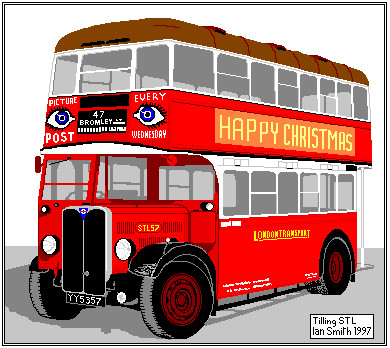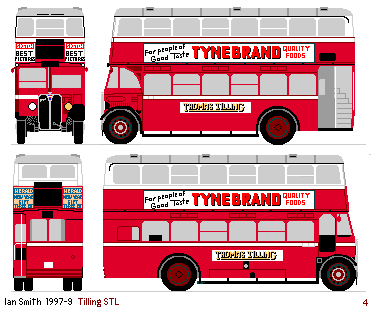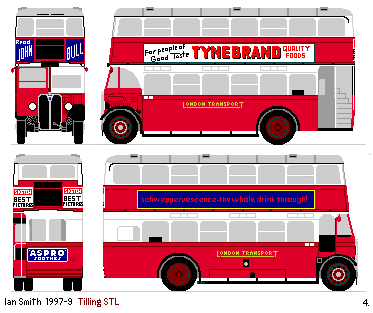

STL 51-130 (Total 80) 8STL4
Chassis: AEC Regent, 16 ft 3in wheel-base, 100mm bore petrol engines,
crash gearboxes, Lockheed brakes.
Body: 56 seater, H30/26, 4 spares.
The LGOC owned 102 double deckers, operated by Tilling on London services,
that needed replacing in 1933, and ordered 102 buses to the new STL length,
to be bodied by Tilling to their own design.
This was substantially different from any of the General STLs - or the London Transport varieties to follow.
 The body had six bays between the front and rear bulkheads, with arched-top windows.
The front of the upper deck had three windows,
the centre one opening - a throwback to the days of external route boards above the cab.
The rear was also rather different, with two small windows perched above the display area.
The displays, at front and back, had two apertures rather than three,
with the route number squeezed onto the destination blind.
They were quite small, being placed high up,
above the prominent arch of the lower saloon ceiling,
that was visible at front and rear.
There was originally a small side route number display blind above the doorway
but London Transport quickly removed these after the takeover,
and used stencil plates by the doorway.
The body had six bays between the front and rear bulkheads, with arched-top windows.
The front of the upper deck had three windows,
the centre one opening - a throwback to the days of external route boards above the cab.
The rear was also rather different, with two small windows perched above the display area.
The displays, at front and back, had two apertures rather than three,
with the route number squeezed onto the destination blind.
They were quite small, being placed high up,
above the prominent arch of the lower saloon ceiling,
that was visible at front and rear.
There was originally a small side route number display blind above the doorway
but London Transport quickly removed these after the takeover,
and used stencil plates by the doorway.
The front side-lights were placed up at cantrail level at first,
although they were moved down later to comply with changed regulations.
The single rear light was on the right of the platform panel.
The front number plate was originally above cab-level,
but was later moved down to the standard position under the radiator.
Likewise the rear number plate, a square plate
originally centrally between the decks,
was replaced by a plate on the rear bulkhead, on the platform.
 They were actually built earlier than the LGOC's own STLs,
but the new London Transport was still dominated by LGOC men,
and it was unthinkable for the new class to have a non-LGOC bus as its doyenne.
So the Tilling STLs were numbered after the LGOC's own first batch.
The official photo of the first Tilling delivery, STL 51,
shows the number ST 837
painted on the front dumb-irons,
indicating that the L prefix was something of an afterthought.
They were actually built earlier than the LGOC's own STLs,
but the new London Transport was still dominated by LGOC men,
and it was unthinkable for the new class to have a non-LGOC bus as its doyenne.
So the Tilling STLs were numbered after the LGOC's own first batch.
The official photo of the first Tilling delivery, STL 51,
shows the number ST 837
painted on the front dumb-irons,
indicating that the L prefix was something of an afterthought.
Only 80 were delivered by the time that the LPTB took over both the LGOC and the London Tillings operations,
and the order for the remaining 22 buses was cancelled.
Some suffered the indignity of wearing "General" fleetnames after the takeover,
before "London Transport" became the norm.
Routes most associated with the sub-class include:
36: Bromley (later Hither Green) - Lewisham - New Cross - Camberwell - Victoria - West Kilburn;
47: Shoreditch - London Bridge - Lewisham - Catford - Bromley - Farnborough;
61: Eltham - Chislehurst - Orpington - Bromley;
64: West Croydon - Addington ;
75: West Croydon - Penge - Catford - Blackheath - Woolwich Ferry;
119: Croydon - West Wickham - Bromley North;
130: West Croydon - New Addington.
 They continued to be operated by the ex Tilling garages:
Bromley (TB), Croydon (TC) and Catford (TL),
although Catford changed over to other types in May 1939.
They continued to be operated by the ex Tilling garages:
Bromley (TB), Croydon (TC) and Catford (TL),
although Catford changed over to other types in May 1939.
Twenty two were destroyed by an air raid on Croydon garage in May 1941,
and others of the class finished the war with extra props, stays and window-bars
to help hold them together.
They remained petrol-engined with crash gearboxes,
which together with their aging and war-worn bodies made them early candidates for withdrawal.
 The arrival of STDs at Croydon in December 1946
displaced eight of the survivors,
which were repainted green and sent into the Country Area,
initially to Hemel Hempstead, and then to Watford.
Two eventually returned to Bromley, adding a touch of green to the 126 route.
The arrival of STDs at Croydon in December 1946
displaced eight of the survivors,
which were repainted green and sent into the Country Area,
initially to Hemel Hempstead, and then to Watford.
Two eventually returned to Bromley, adding a touch of green to the 126 route.
At Bromley, the increasingly unreliable performance of their petrol fleet,
including the Tillings,
gave rise to the hire from Leeds of a variety of AEC Regents
until the arrival of RTs eased the situation.
Most of the Tillings STLs gave up the ghost in 1948,
although a few staggered on seeing occasional use in the Special Events fleet.
All were despatched to the scrapman.
 Tilling bus histories
Tilling bus histories
 photo references
photo references

STL 131-152
these numbers, allocated to the unbuilt Tilling STLs, were never re-allocated.

 Bus Stop
Bus Stop
 contents
contents
 Generals
Generals
 Tillings
Tillings
 leaning-backs
leaning-backs


 The body had six bays between the front and rear bulkheads, with arched-top windows.
The front of the upper deck had three windows,
the centre one opening - a throwback to the days of external route boards above the cab.
The rear was also rather different, with two small windows perched above the display area.
The displays, at front and back, had two apertures rather than three,
with the route number squeezed onto the destination blind.
They were quite small, being placed high up,
above the prominent arch of the lower saloon ceiling,
that was visible at front and rear.
There was originally a small side route number display blind above the doorway
but London Transport quickly removed these after the takeover,
and used stencil plates by the doorway.
The body had six bays between the front and rear bulkheads, with arched-top windows.
The front of the upper deck had three windows,
the centre one opening - a throwback to the days of external route boards above the cab.
The rear was also rather different, with two small windows perched above the display area.
The displays, at front and back, had two apertures rather than three,
with the route number squeezed onto the destination blind.
They were quite small, being placed high up,
above the prominent arch of the lower saloon ceiling,
that was visible at front and rear.
There was originally a small side route number display blind above the doorway
but London Transport quickly removed these after the takeover,
and used stencil plates by the doorway.
 They were actually built earlier than the LGOC's own STLs,
but the new London Transport was still dominated by LGOC men,
and it was unthinkable for the new class to have a non-LGOC bus as its doyenne.
So the Tilling STLs were numbered after the LGOC's own first batch.
The official photo of the first Tilling delivery, STL 51,
shows the number ST 837
painted on the front dumb-irons,
indicating that the L prefix was something of an afterthought.
They were actually built earlier than the LGOC's own STLs,
but the new London Transport was still dominated by LGOC men,
and it was unthinkable for the new class to have a non-LGOC bus as its doyenne.
So the Tilling STLs were numbered after the LGOC's own first batch.
The official photo of the first Tilling delivery, STL 51,
shows the number ST 837
painted on the front dumb-irons,
indicating that the L prefix was something of an afterthought.
 They continued to be operated by the ex Tilling garages:
Bromley (TB), Croydon (TC) and Catford (TL),
although Catford changed over to other types in May 1939.
They continued to be operated by the ex Tilling garages:
Bromley (TB), Croydon (TC) and Catford (TL),
although Catford changed over to other types in May 1939.  The arrival of STDs at Croydon in December 1946
displaced eight of the survivors,
which were repainted green and sent into the Country Area,
initially to Hemel Hempstead, and then to Watford.
Two eventually returned to Bromley, adding a touch of green to the 126 route.
The arrival of STDs at Croydon in December 1946
displaced eight of the survivors,
which were repainted green and sent into the Country Area,
initially to Hemel Hempstead, and then to Watford.
Two eventually returned to Bromley, adding a touch of green to the 126 route.
 Tilling bus histories
Tilling bus histories Bus Stop
Bus Stop contents
contents Generals
Generals Tillings
Tillings